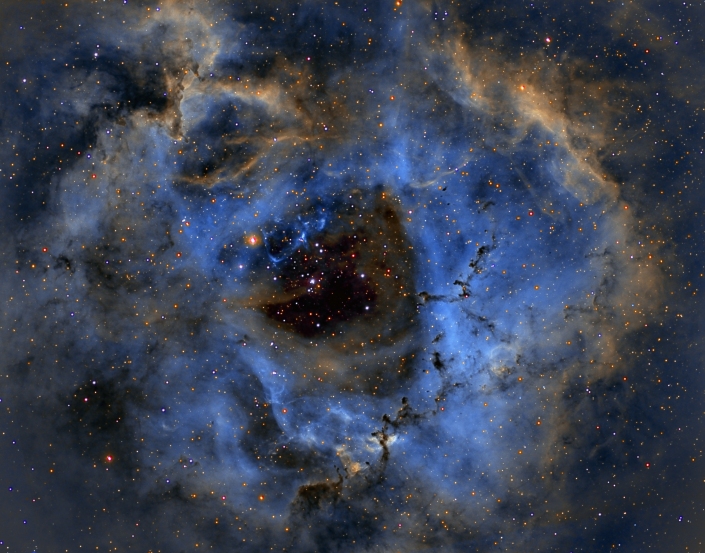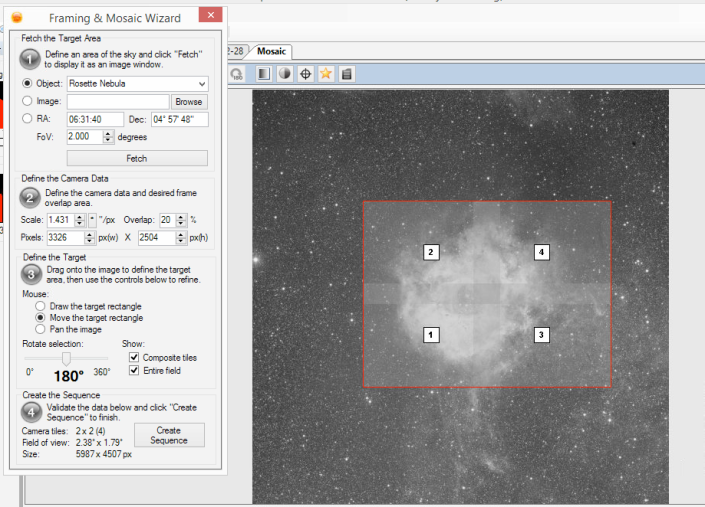Workflow
Making the Rosette Nebula Mosaic
My imaging field of view is 1.37° x 1.03° (more on this here), which is very limiting when targeting large nebula. As you can see below, My image of the Rosette Nebula is too contained. The nebula has no room to “float” in space.
I wanted a 2°x 2° image so my options were either a smaller telescope or a mosaic.
If you are new to astrophotography, I strongly recommend you start with Starizona’s guide to imaging.
Planning the Mosaic
To create the 2°x 2° mosaic of the Rosette Nebula in narrowband I used Sequence Generator Pro‘s Framing and Mosaic wizard. With some rotation, I was able to fit nebula in the 2×2 frame mosaic.
The planning session in Skysafari estimated roughly 5 hours or imaging per night (less with the ever time consuming meridian flip)
Imaging Sessions
Light pollution: Bellevue is a city. Is rank 7-8 in the Bortle Scale. For a light pollution map go here. For a great article about the effects of light pollution on astrophotography go here. I will be using Narrowband filters Ha, OIII and SII. In previous attempts I had good results with 20 minute exposures in Ha and 30 minute exposures in OIII and SII.
Number of frames: Astro images straight out of the camera tend to be noisy. The Signal to Noise Ratio (SNR) of an image can be increased in post processing using image integration (combination) . Post processing requires multiple images of the same object (Light frames or subs), and multiple calibration frames (Bias, Darks, Flats). More here. A very effective image integration algorithm is Winsorization but it requires at least 8 frames per filter. (For a deeper dive on image integration go here.)
Time, time, time: In the section above I determined that I have a 5 hour imaging window. Prior to the first image of the night, the telescope has be focused, find where it points to the sky, calibrate its autoguider, then slew to the target, center, rotate, focus again, wait for the autoguider to settle and then start imaging. That routine averages 10 minutes and takes away from pure imaging. Another time sink is a meridian flip, a maneuver by the mount to reposition the telescope on the target when it crosses the Meridian. After a flip which usually takes 2-5 minutes all the startup steps apply so the overall cost is 12-15 minutes. That cuts the imaging window to 4 hours and 30 minutes.
Overall:
Ha = 8 subs x 20m x 4 mosaic frames ~ 11 hours ~ 3 nights
OIII = 8 subs x 30m x 4 mosaic frames ~ 16 hours ~ 4 nights
SII = 8 subs x 30 m x 4 mosaic frames ~ 16 hours ~ 4 nights
The minimum number of imaging sessions is 8 nights. That is… 11 clear February/ March nights in Seattle.
Global warming to the rescue “Seattle sets twin records for warmest February, winter on record”
Starting with Ha
January 28-29th, 2015 : 8 x 20 min subs of the central region
February 22-23rd , 2015 : 8 x 20 min subs of top right and left areas
February 23-24th , 2015 : 8 x 20 min subs of the bottom right and left areas
Due to a probable but yet unidentified user error, the bottom frames were not overlapping with the top. So the first mosaic attempt had some missing areas
March 1st, 2015: 8 frames of the missing left side
The two extra frames added 3 more nights imaging in order to have all the necessary frames. But the Mosaic is complete












